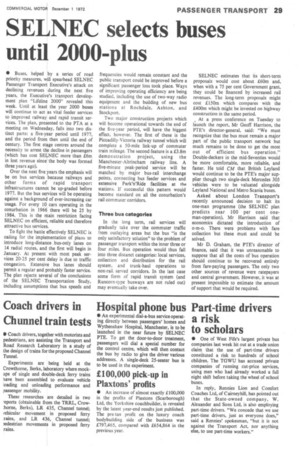SELNEC selects buses until 2000-plus
Page 31

If you've noticed an error in this article please click here to report it so we can fix it.
• Buses, helped by a series of road priority measures, will spearhead SELNEC Passenger Transport Executive's attack on declining revenues during the next five years, the Executive's transport development plan "Lifeline 2000" revealed this week. Until at least the year 2000 buses will continue to act as vital feeder services to improved railway and rapid transit services. The plan, presented to the PTA at a meeting on Wednesday, falls into two distinct parts: a five-year period until 1977, and the period from then until the end of century. The first stage centres around the necessity to arrest the decline in passengers (which has cost SELNEC more than £6m in lost revenue since the body was formed three years ago).
Over the next five years the emphasis will be on bus services because railways and other forms of rapid transport infrastructures cannot be up-graded before 1977. But the bus services will be operating against a background of ever-increasing car usage. For every 10 cars operating in the conurbation in 1966 there will be 25 by 1984. This is the main restriction facing SELNEC on efficient, reliable and therefore attractive bus services.
To fight the battle effectively SELNEC is calling for the implementation of plans to introduce long-distance . bus-only lanes on 14 radial routes, and the first will begin in January. At present with most peak services 20-25 per cent delay is due to traffic congestion. Extensive bus lanes should permit a regular and probably faster service. The plan rejects several of the conclusions of the SELNEC Transportation Study, including assumptions that bus speeds and frequencies would remain constant and the public transport could be improved before a significant passenger loss took place. Ways of improving operating efficiency are being studied, including the use of two-way radio equipment and the building of new bus stations at Rochdale, Ashton, and Stockport.
Two major construction projects which will become operational towards the end of the five-year period, will have the biggest effect, however. The first of these is the Piccadilly-Victoria railway tunnel which will complete a 50-mile link-up of commuter train mileage. The second feature is a £3,8m demonstration project, using the Manchester-Altrincham railway line, A five-minute peak-period service will be matched by major bus-rail interchange points, connecting bus feeder services and extensive Park'n'Ride facilities at the stations. If successful this pattern would become standard on all the conurbation's rail commuter corridors.
Three bus categories In the long term, rail services will gradually take over the commuter traffic from outlaying areas but the bus "is the only satisfactory solution" to the problem of passenger transport within the inner three or four miles. Bus operation would thus fall into three distanct categories: local services, collection and distribution for the rail system, and trunk-haul operations to non-rail, served corridors. In the last case some form of rapid transit system (and Runcorn-type busways are not ruled out) may eventually take over. SELNEC estimates that its short-term proposals would cost about £60m and, when with a 75 per cent Government grant, they could be financed by increased rail revenues. The long-term proposals might cost £150m which compares with the £400m which might be invested on highway construction in the same period.
At a press conference on Tuesday to launch the report, Mr Geoff Harrison, the PTE's director-general, said: "We must recognize that the bus must remain a major part of the public transport network but much remains to be done to get the most out of efficient bus operation," Douhle-deckers in the mid-Seventies would be more comfortable, more reliable, and faster. He told CM that British Leyland would continue to be the PTE's major supplier though two single-deck Mercedes 305 vehicles were to be valuated alongside Leyland National and Metro Scania buses.
Asked about London Transport's recently announced decision to halt its one-man programme (the SELNEC plan predicts near 100 per cent oneman-operation), Mr Harrison said that economics dictated the introduction of o-m-o. There were problems with fare collection but these must and could be solved.
Mr D. Graham, the PTE's director of finance, said that it was unreasonable to suppose that all the costs of bus operation should continue to be recovered entirely from fare-paying passengers. The only two other sources of revenue were ratepayers and central government. However, it was at present impossible to estimate the amount of support that would be required.
































































































































